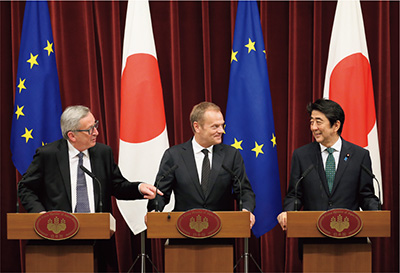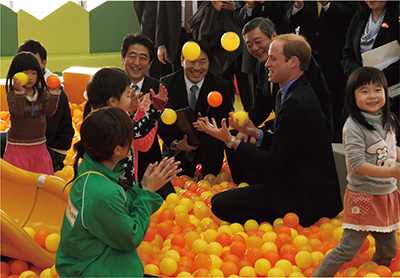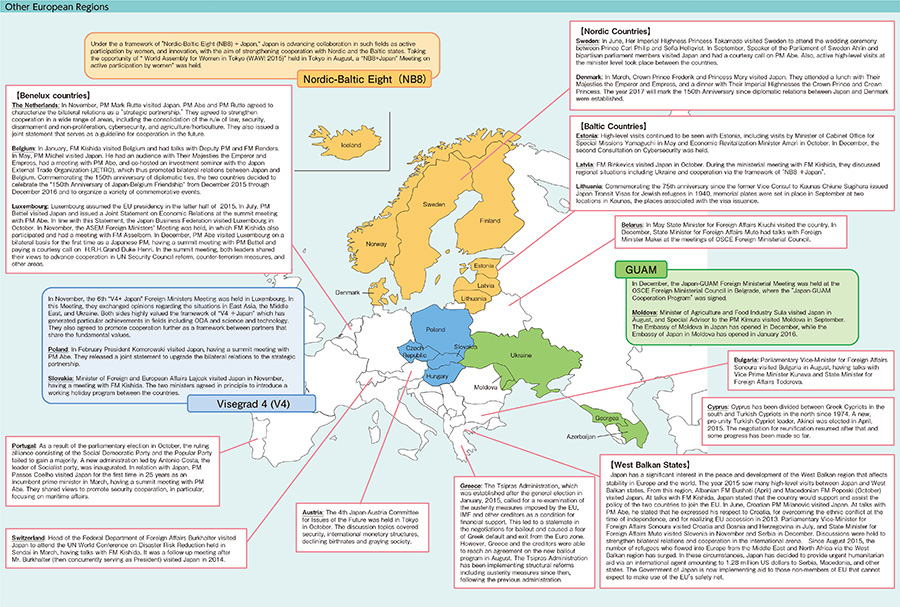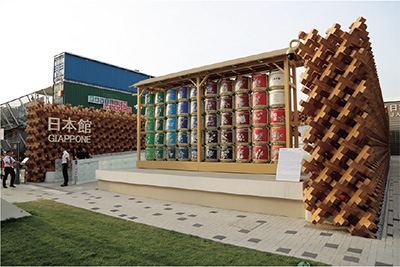Diplomatic Bluebook 2016
Chapter 2
Japan’s Foreign Policy that Takes a Panoramic Perspective of the World Map
1.Situation of European Region
(1) European Union (EU)
The EU is a political and economic entity consisting of 28 member states with a total population of about 500 million that generates about 24% of the world’s GDP. Sharing basic values and principles, the EU is an important partner for Japan in addressing global issues.
A. Japan-EU Relations
In 2015, there were major developments toward strengthening Japan-EU relations in a comprehensive manner. In particular, two Japan-EU summit meetings were held during the year, which strengthened the close bonds of trust among the leaders.
In May, the 23rd Japan-EU Summit Meeting was held in Tokyo with the participation of President of the European Council, Donald Tusk, President of the European Commission, Jean-Claude Juncker, and other European Commissioners. At this meeting, both leaders shared the view to further accelerate the Japan-EU Strategic Partnership Agreement (SPA) and the Japan-EU/EPA, as well as to strengthen cooperation in diverse areas such as counter-terrorism, humanitarian assistance, science and technology, oceans and seas, outer space and cyberspace. In November, Prime Minister Abe held a meeting with European Commission President Juncker, on the occasion of the G20 Antalya Summit. At this meeting, both leaders confirmed the importance of the SPA and EPA negotiations. Concerning the EPA negotiations, they shared the view to continue to make their utmost efforts to reach agreement in principle on the EPA at the earliest possible time in 2016. In this context, six rounds of Japan-EU EPA negotiations (see 3-3-1) and four rounds of Japan-EU SPA negotiations were held during 2015.
 The 23rd Japan-EU Summit (joint press conference) (May 29, Tokyo; photo: Cabinet Public Relations Office)
The 23rd Japan-EU Summit (joint press conference) (May 29, Tokyo; photo: Cabinet Public Relations Office)In January Foreign Minister Kishida visited Belgium and had talks with the High Representative of the European Union for Foreign Affairs and Security Policy /Vice-President of the European Commission, Federica Mogherini and other officials, agreeing to collaborate to further strengthen Japan-EU relations, while forging a relationship with the new leadership. The Foreign Minister also met with High Representative Mogherini at the G7 Foreign Ministers’ Meeting (Lubeck) in April and the ASEM Foreign Ministers’ Meeting in November, where they agreed to closely cooperate on the Iranian nuclear issue and the Ukraine crisis.
B. Recent Development of the EU
As a step toward expansion and deepening of European integration, Lithuania became the 19th country to introduce the Euro in January 2015. On the other hand, the influx of refugees from the Middle East and North Africa to Europe surged, which prompted the EU to take the issue seriously and express their determination to work in solidarity to resolve the situation. In November, an international summit to discuss migration and refugee issues between EU and African leaders took place in November at Valletta, Malta(Valletta Summit for migration), and a Political Declaration and Action Plan for an early solution of the issue were issued. At the EU-Turkey Summit meeting held in Brussels at the end of the month, the leaders committed to continuing humanitarian assistance to Turkey to resolve migration issues. They also agreed to revitalize the Turkey’s accession negotiations with the EU, committing to advance the preparation for negotiations starting in the year 2016.
In July, EU High Representative Mogherini and Iranian Foreign Minister Zarif released the final agreement (Joint Comprehensive Plan of Action) between with EU3 (UK, France, and Germany) +3 (U.S., China, and Russia) and Iran, playing an important role in a solution of the issue. In respect of the Ukraine crisis, the 2nd EU-Ukraine Association Council meeting was held in December. The officials confirmed the significance of cooperation in a solution for the issue and welcomed the progress in the situation.
In the security area, in June, EU High Representative Mogherini’s initiative lead to the European Council’s decision to develop an EU Global Strategy as the EU’s comprehensive security strategy.
Regarding the economy, a moderate economic recovery is holding up, supported by the low price of crude oil, a weak Euro, and monetary easing policy throughout the Euro area. In efforts for sustainable growth by the European Commission, progress took place mainly in policies to stimulate investments, including the establishment of a legal framework for “Investment Plan for Europe,” the selection of investment projects, and the development of action plan for building a Capital Markets Union. Concerning the downside risks to the economy, there was serious concern about impacts of the Greece debt crisis on the European economy from the beginning of the year. The situation, however, has stabilized since the Government of Greece and the EU side reached an agreement on support program in August.
(2) United Kingdom
In the election of the House of Commons held in May, the Conservative Party led by Prime Minister David Cameron won a majority of the seats and his second administration was established as a single-party majority government of the Conservatives. Prime Minister Cameron intends to hold a referendum on June 23, 2016, on whether to remain in the EU or to leave. He aims to accomplish a reform of the EU till then and to remain in the EU. In November, Prime Minister Cameron submitted a plan of the EU reform consisting of the four pillars; “Economic governance (protecting the rights of non-euro members states, etc.),” “Competitiveness (Deregulations, etc.),” “Sovereignty (recognition that reference to “ever closer union” does not apply to the UK, and greater powers for national parliaments),” and “Social benefits and free movement (prevention of abuse of freedom of movement within the EU, restrictions on welfare benefits to immigrants).” Based on this reform plan, the UK hold negotiations with the EU and the European Council and reached an agreement at its meeting in February. Also, deciding how much power to devolve from the central government to Scotland is an important issue for the administration.
 Prince William, communicating with local people in the quake-hit area (February 28, Fukushima; photo: Cabinet Public Relations Office)
Prince William, communicating with local people in the quake-hit area (February 28, Fukushima; photo: Cabinet Public Relations Office)Both Japan and the UK have been strengthening bilateral ties through policy coordination and exchanges at various levels including prime ministers and foreign ministers. Prime Minister Abe and Prime Minister Cameron held summit meetings on the occasion of the G7 Summit in June and the G20 Summit in November. Foreign Minister Kishida met with UK Foreign Secretary Philip Hammond on the occasion of the G7 Foreign Ministers’ Meeting in April. The Fourth Japan-UK Foreign Ministers’ Strategic Dialogue was held in August and the Fifth was held in January 2016 respectively in Tokyo. In February 2015, His Royal Highness, The Duke of Cambridge (Prince William) visited Japan. The Duke of Cambridge, together with Prime Minister Abe, visited the region affected by the Great East Japan Earthquake. He was invited by Their Majesties the Emperor and Empress for luncheon, and communicated with many people. In August, Speaker of the House of Commons John Bercow visited Japan. He paid a courtesy call on Prime Minister Abe and exchanged views with Speaker of the Houses of Representatives and the President of the House of Councilors.
In recent years, security and defense cooperation has been advanced between Japan and the UK. In November, the UK Government released a new “National Security Strategy (NSS)” and “Strategic Defense and Security Review (SDSR),” identifying Japan as “ally” and the “closest security partner in Asia.” Following the First UK-Japanese Foreign and Defense Ministers’ Meeting held in London in January 2015, the second Meeting took place in Tokyo in January 2016. In this meeting, both parties confirmed that they would promote negotiations toward an early conclusion of the Acquisition and Cross-Servicing Agreement (ACSA).
(3) France
With an unemployment rate exceeding 10%, the Hollande administration is working for economic recovery and job creation, aiming at fiscal consolidation, and promoting such measures as the liberalization of economic activities. The Government of France has been strengthening counter-terrorism measures in the wake of terrorist attacks against the office of a newspaper and others in Paris in January, and the simultaneous terror attacks in Paris in November causing 130 casualties. Regarding the issue of refugees coming from the Middle East and North Africa to Europe, the ruling Socialist Party announced that France would provide assistance including intake of 24,000 refugees over the two years. However, the ruling party lost in the prefectural assembly election in March and in the provincial election in December, in which the Front National Party that insists on capping the influx of migrants increased its seats.
On the diplomatic front, the Government of France intensified air raids in Syria due to the involvement of the Islamic State of Iraq and the Levant (ISIL) in the terrorist attacks. Also, France hosted the 21st United Nations Framework Convention on Climate Change (COP21) Summit Meeting after the terrorist attacks in November. France demonstrated its leadership in adopting the Paris Agreement and played a significant role in taking measures for climate change.
As for its relations with Japan, Foreign Minister Kishida visited France and had a talk with French Minister of Foreign Affairs and International Development Laurent Fabius in January. In March, the second Japan-France Foreign and Defense Ministers’ Meeting was held in Tokyo. Both sides signed an agreement concerning the transfer of defense equipment and technology and confirmed further cooperation in the fields of security and defense. In October, Prime Minister Valls visited Japan, sharing the view to make greater cooperation in such fields as innovation, Africa and nuclear power. Taking this opportunity, the “Japan-France Innovation Year” was launched. In November, Prime Minister Abe visited France to attend the COP21 and held a meeting with President Hollande and Prime Minister Valls. They confirmed cooperation on such areas as counter-terrorism and climate change. Also, Prime Minister Abe laid flowers at the Bataclan theater, which was one of the sites of multiple terrorist attacks in Paris, in order to demonstrate solidarity with France.
(4) Germany
As the chair of the G7 Summit in 2015, Germany held the Elmau Summit in June, leading the discussions about the G7 countries’ response to the Ukraine crisis, situation in the Middle East and other issues. As a member of the Normandy format (Ukraine, Germany, France, and Russia), Germany has been proactively working on stabilization of Ukraine situation. In spite of the surging refugees, Chancellor Angela Merkel did not put quotas on the number of refugees entering Germany in 2015. The number continued to rise, totaling about 1.1 million refugees entering Germany throughout the year.

Also, Germany set forth a stance of actively contributing to the peace and stability of the international society. In response to the simultaneous terrorist attacks that took place in Paris in November, the German Bundestag approved deployment of the Federal Armed Forces to support military actions against ISIL in December.
Regarding the economy, Germany maintains a stable economy even after the European debt crisis and functions as a driving force of the European economy. In the area of manufacturing, Germany developed the “Industry 4.0” strategy that aims for more optimized and efficient production by connecting factories and companies, using common software. Germany has been increasing its economic influence in the international society.
As for its relations with Japan, Chancellor Merkel visited Japan in March, met with Prime Minister Abe and agreed to deepen cooperation in the international arena, such as issues on regional situations, Security Council reform, disarmament, and non-proliferation. Also, as the current and next-term chairs of the G7 Summit meetings, the two countries need to maintain close cooperation in dealing with various global issues. To this end, the two sides had multiple summit and foreign ministers’ meetings by utilizing occasions at the international conferences such as G20, after the Elmau Summit, which deepened the trusting relationships and increased the closeness between the two countries.
(5) Italy and Spain
In Italy, Prime Minister Matteo Renzi took office in February 2014, and has been continuously engaged in a series of structural reforms, ranging from revising election laws, revising the Constitution that would allow reforming the Senate, and improving the labor market. In February 2015, President Sergio Mattarella assumed office.
Expo Milano 2015 was held from May to October with the slogan “Feeding the Planet, Energy for Life,” attracting 21.5 million visitors. Japan took part in this expo with the theme of “Coexisting Diversity.” The Japanese pavilion proved popular, attracting 2.28 million visitors, and winning the gold award for the best exhibition design.
As for relations with Japan, Prime Minister Renzi and his spouse visited Japan in August. He and his spouse were received in audience by Their Majesties the Emperor and Empress, and Prime Minister Renzi had a summit meeting with Prime Minister Abe. Foreign Minister Kishida had a talk with Minister of Foreign Affairs and International Cooperation Paolo Gentiloni when he attended the G7 Foreign Ministers’ Meeting in April. The year 2016 marks the 150th anniversary of diplomatic relations between Japan and Italy. Taking this opportunity, both countries will further advance cooperation.
The Rajoy administration of Spain has been working on fiscal and structural reform and its economy is making a gradual recovery. However, the approval ratings for the ruling party, “Partido Popular (People’s Party),” and the largest opposition party, “Spanish Socialist Workers’ Party (PSOE),” have declined due to the high unemployment rate of young people and allegations of illegal fund operation. In December the Spanish general elections for both houses were held at the expiration of terms of office this period. The ruling People’s Party failed to win a majority of seats. Following the result of elections to the Parliament of Catalonia in September, pro-independence leader, Carles Puigdemont, assumed office as a newly elected governor. Attention should be continuously paid to the movement of this Province toward independence.
In relations with Japan, there has been continuous momentum of exchanges which was increased on the occasion of the “400th anniversary of exchanges between Spain and Japan” between 2013 and 2014. The year 2015 saw a more than 25% increase in the number of travelers between two countries at the end of September, compared with the year-earlier period.
 Japan Pavilion
Japan PavilionteamLab took charge of two spaces called “HARMONY” and “DIVERSITY” in the Japan Pavilion at the Expo Milano 2015. “HARMONY” showed four seasons of terraced rice fields through a new immersive experience type visual space. In the “DIVERSITY” space, various pictures of Japanese food floated down in a digital waterfall. The audience was able to download and take home these images and their detailed information via smartphone by touching the floating pictures. By connecting a waterfall, as a symbolic art which could provide experience for the people in the same space simultaneously, to smartphones, we took on a challenge to realize the coexistence of sharing an excitement and convenience of accessing to information.
At the Expo, the Japan Pavilion was awarded Gold Award in the category for “exhibition design” for the first time in history. The harmony between nature and technology was said to be one of the reasons that led us to the Gold Award. Also, in the Pavilion Award, given by an American company EXHIBITOR Magazine, Inc., “HARMONY” was awarded “Best Presentation,” which we think greatly contributed to winning of the Gold Award.
To talk about “HARMONY” a little more, “paddy field” which is the original landscape of Japanese food, and typically represented by terraced rice fields, was developed in places where there is a difference in height, such as middle- and up-stream basins. It was also created by the coexistence of humankind and nature. In order to express that paddy fields were developed in places where there is a “difference in height” and to display “humankind living in coexistence with nature,” we filled the space with many screens representing rice grown at various heights from the level of waist to below knees, thereby creating an interactive visual space where the vision infinitely extends at a height between waist to knees. Images on the screens continue to change in accordance with the position and movement of people. You can experience the four seasons of Japan’s nature by entering the visual space as if you are stepping into a rice field.
Behind the scenes, there is the notion of “Spatial Objects,” which is the art concept proposed by the teamLab. To put it another way, it is a concept that you can go into a three-dimensional object, while still recognizing it as a three-dimensional object, by a new digital representation. Under such a new concept, we wanted people all over the world to experience a completely new feeling of immersion allowing them to go inside a physical work.
 “HARMONY”
“HARMONY” “DIVERSITY”
“DIVERSITY”(6) Ukraine
In February, the leaders of Ukraine, Germany, France and Russia agreed on a “Package of Measures for the Implementation of the Minsk Agreements” including an immediate ceasefire and the withdrawal of all heavy weapons. Although fighting intensified temporarily (in June and August) with sporadic battles after March, violations of the ceasefire decreased on the whole. The ceasefire was generally maintained in September and October. However, the number of ceasefire violation cases again increased from November to December.
In February, in response to Ukrainian economic downturn triggered by protracted conflicts, the IMF approved a support program to contribute approximately 17,500 million US dollars to Ukraine over four years. Donor states/organizations including Japan continued their economic and financial assistance to the country. Supported by the global community, Ukraine has been working for a range of domestic reforms, including anticorruption measures and economic reform.
Regarding diplomacy, Ukraine is paving the way towards European integration with the Deep and Comprehensive Free Trade Agreement (DCFTA) between the EU and Ukraine entering into force on January 1, 2016. On the other hand, the natural gas issue remains unsolved with Russia. By reversing flows of gas from Europe, Ukraine is engaging in the diversification of energy supply sources.
Regarding relations with Japan, high-level communications increasingly took place; Foreign Minister Pavlo Klimkin visited Japan in March, and Prime Minister Abe visited Ukraine in June (the first-ever visit by an incumbent Japanese Prime Minister), and a Japan-Ukraine Summit Meeting was held in September. Bilateral relations also steadily advanced, with the Japan-Ukraine Investment Agreement coming into force in November, and the Third Meeting of the Japan-Ukraine Joint Committee for the Cooperation to Advance Aftermath Response to Accidents at Nuclear Power Stations was held. Regarding Japan’s assistance to Ukraine, Japan pledged additional aid of 300 million US dollars in January. In August, the Government of Japan dispatched an expert to the OSCE Special Monitoring Mission to Ukraine (SMM), supporting Ukraine in both financial and personnel aspects.

